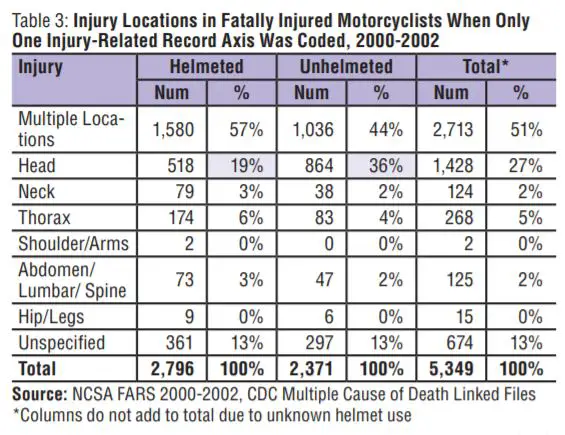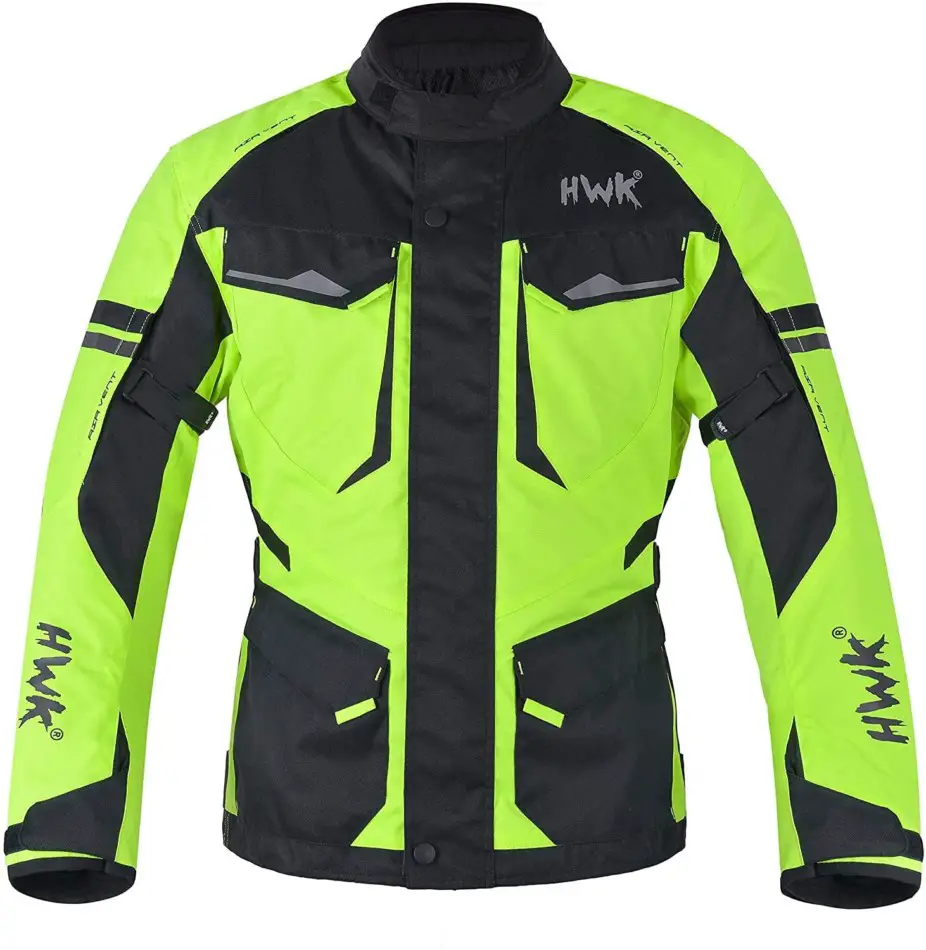Many new motorcyclists forget to budget for safety gear when they buy their first bike. A helmet is a no-brainer, but what about a motorcycle jacket? Is it really necessary?
A motorcycle jacket with padded inserts will protect your elbows and shoulders against minor impact injuries and abrasion at the pads. Bike jackets without reinforcing material are no better than regular leather or denim jackets to prevent abrasion injuries. In a serious, high-speed crash, a jacket is unlikely to save your life, but a helmet could.
So does that mean I don’t need to wear a motorcycle jacket? Wait a minute, not so fast…
How Much Protection Does a Motorcycle Jacket Offer in a Crash?
When you fall or crash your motorcycle, there are two main types of injuries that could ruin your day (or worse, your life): impact injuries and abrasion. Impact injuries result in broken bones or puncture wounds, while abrasion is when your skin comes off as you slide across the asphalt. Generally, high impact injuries kill, while abrasion injuries ruin your showers for the next few weeks as you try to clean the wounds without screaming.
So how much does a motorcycle jacket help with these?
Impact protection: A 2012 study found that motorcycle jackets were not effective at preventing thoracic, spinal, abdominal injuries, or fractures of the upper extremities. Jackets did, however, offer protection against soft-tissue damage. When you hit something hard at a high speed, a motorcycle jacket won’t prevent you from getting seriously hurt or killed. But most motorcycle crashes do not happen at high speeds. In fact, a Motorcycle Accident In depth Study (MAIDS) found that 75% of all motorcycle crashes happen at speeds of 35 mph (50 kph) or slower.
Bikes are harder to control when riding at very low speeds. And dropping your bike at walking pace is more likely to hurt your legs and ankles as your bike falls on top of you. Most riders also instinctively try to catch themselves, often resulting in injuries to hands and wrists. A motorcycle jacket won’t prevent you from a fracture in either.
Abrasion protection: Motorcycle jackets made from leather or other fabric with high abrasion and tear resistance can prevent or reduce 43% of injuries to soft tissue and 63% of deep and extensive injuries according to Schuller et al (1986). A study published in the NTSB Motorcycle Safety Forum by Liz de Rome explains how protective clothing like motorcycle jackets can prevent or reduce cuts, abrasions, friction burns and the stripping away of skin and muscle. Ouch! It may also reduce the likelihood of infections which may delay complete healing.

The MAIDS study showed that around 40% of riders tumbled or slid across the road without hitting anything else, and that 49% of all the injuries were rated to be minor. These common injuries are mostly preventable by wearing a protective clothing including a motorcycle jacket. The legs have their own worries, so if you want to know whether it is worth it to form out cash for motorcycle pants, read this comprehensive article I wrote.
It is also worth noting that sliding in loose gravel, while painful, won’t nearly abrade as much as tarmac. And the higher the speed, the longer the slide. I once fell at low speed in the Chalbi Desert in Northern Kenya. My jacket sleeve pushed up so I fell on bare skin. I rubbed some salt into it and carried on. Within two weeks the scar was gone. If this was on the tarmac at speed, I’d have been in hospital for days.

In short, while a motorcycle jacket will probably not save your life in a high impact crash, it will most likely save your skin. And it doesn’t have to be expensive either. Any of these jackets will be 100% better than no jacket at all.
Are Motorcycle Jackets Better Protection Than Leather or Denim?
Since motorcycle jackets mainly prevent road rash instead of impact injuries, does that mean you’ll be just as safe in a leather or other long-sleeve jacket? Interestingly, De Rome found that motorcycle jackets without body armor (like Kevlar inserts) do not give significantly more protection than clothing not designed for motorcycle use.
In order to be effective, you need to wear a jacket with armored pad inserts in the elbows and shoulders. The body armor will take much longer to wear away, which will save your skin (or flesh – ouch!).
Most Likely vs Most Deadly Motorcycle Accidents
Obviously, ATGATT is first prize. That stands for All the Gear, All the Time. Dress for the slide, not for the ride! Does that mean that you need to don your full kit if you ride the 800 yards to the corner shop for milk? For some, yes.
The most risk averse riders may go all out on the gear on each ride, even the short ones. But it remains a decision that requires judgement each time before you get onto the bike. Maybe a look at the most likely and most deadly injuries may help make a more informed decision.
Most likely injuries: In a study of more than 1.2 million motorcycle crash victims that were admitted to emergency rooms over 8 years, the CDC found that you are most likely (30% of riders) to hurt your lower extremities (tibia and fibula mostly). This is followed by head and neck injuries at 22%. Since the majority of crashes are at low speeds, serious injuries to the thorax and abdomen are less common. Yes, arms break when riders try to catch themselves, but a jacket is unlikely to prevent a broken Radius or Humerus. Long sleeves will at least prevent deep road rash and a lengthy recovery period.
Most deadly: Fatalities usually result from crashing into something solid where a jacket won’t prevent internal damage caused by hard impact. According to the NHTSA who tracked death certificates of 8 539 riders over 3 years, riders often get killed by multiple injuries. In instances where only one injury were reported, head injuries (19%) were the most common, followed by the thorax (6%) and the abdomen and spine (3%). Fatal injuries to the thorax and abdomen are unlikely to be prevented by wearing a motorcycle jacket, but a chest protecting pad insert may mean the difference between recovery and not making it.

In short, you are unlikely to die just because you didn’t wear your jacket. The same cannot be said for a helmet. Non-helmeted riders died of head injuries 36% of the time. So get the helmet first (to save your life), then the boots (because you’re probably going to fall on them). And if you’ve got some spare cash, get the best gloves, jacket and pants you can afford. And then, wear them!
Safety Standards that Regulate Motorcycle Jackets
In the U.S. there are no government standard setting organizations. Any private organization can set a standard and try to get the market to adopt it. In the European Union, however, there is CE 13595-2:2002. In order for motorcycle jackets to carry the CE Marking, it has to be independently tested and certified that it conforms to the relevant European safety standards.
There are separate CE standards for impact protectors (EN 1621-2:2003) and the EN 13595 standards for jackets (and pants) have different tests for abrasion resistance and burst strength.
Motorcycle Jacket Benefits Other than in a Crash
Apart from protection against abrasion, and possibly some light impact to certain areas, motorcycle jackets have other benefits which may add to the rider’s safety. These include:
Visibility: Nearly half of all motorcycle accidents that collide with other vehicles are, in part, to be blamed on poor visibility. Car drivers just don’t see bikers. Most motorcycle specific jackets have reflective inserts which will increase your chances of being seen and avoided. A bright helmet is a must, but the more you stand out the better.

Cold stress: A comfortable rider is a safe rider. When your body gets cold, blood flow is restricted to your extremities to keep your core temperate up. This may affect your ability to operate the controls of the bike. Reaction times may be slowed due to the discomfort and stress of being very cold, and there is evidence to suggest that a lower core temperate may increase anxiety and irritability. This, in turn, may be detrimental to good decision making. It sucks to be cold. The right winter jacket will keep the wind out when all the vents are closed.
Wet stress: There are few things worse than wet clothes on a motorcycle. Apart from the discomfort, wet clothes will rapidly cool the body and cause the above-mentioned cold stress. You need a waterproof jacket that can still breathe. A PVC overcoat may keep the rain out, but it also keeps the sweat in which may cool you as the moisture transfers the heat away from your body.
Heat stress: Many riders don’t wear their jackets when it is too hot. I’ve certainly been guilty of this, and I’ve seen my wife crash into the back of a car without her jacket on (it was 105 degrees out). She was luckily travelling slowly and didn’t fall on her arms, but it could have been much worse. Summer jackets have vents in the right places, but still offer abrasion resistance and padding. Interestingly, jackets can prevent dehydration by preventing your bare skin from absorbing heat from the sun.
Fashion: Arguably the most important aspect, for some, is what the jacket looks like. Bikers want to look cool! If you are able to wear the jacket once you reach your destination (the office, or a date maybe…) you will be more likely to put it on in the first place. And only by wearing a jacket when you crash will it do you any good. I’ve found a whole range of good looking jackets online at Viking Cycle.
Conclusion: Should I Wear a Motorcycle Jacket or Not?
It’s up to you, but the fact is that a good quality CE certified jacket with CE certified impact protection pads is the best.
If you can’t afford it, a cheap motorcycle jacket with cheap pad inserts are better than a normal jacket.
If you’re a cheapskate, any old long sleeve jacket is better than no jacket at all.
Ride safe!
